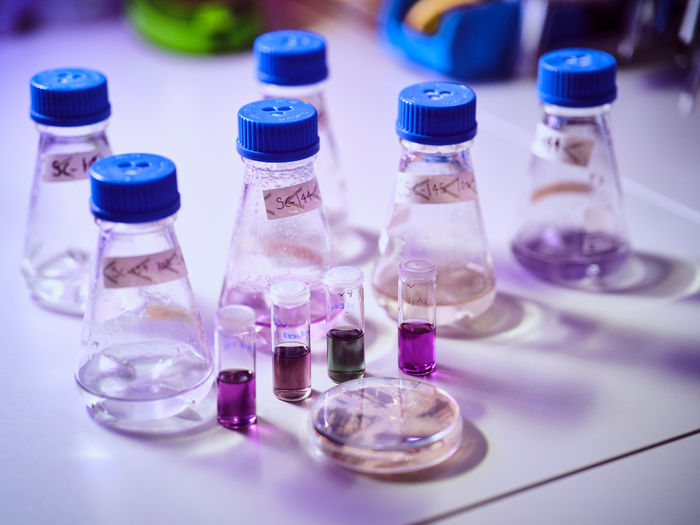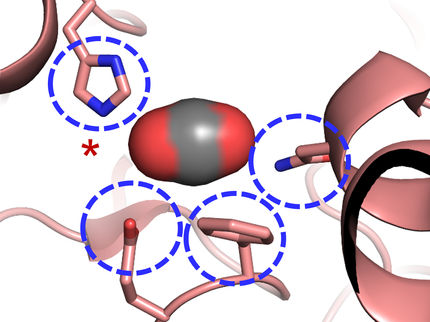Most colors are eco criminals: Here’s how to make purple greener
Goodbye to crude oil-based dyes: Biotech start-up and scientists revolutionize paint production
The colors of our clothes, cosmetics, furniture and all sorts of things around us are nearly all based on crude oil, making them far from environmentally innocent. University of Copenhagen researchers have teamed up with Danish biotech start-up Octarine Bio to create new types of sustainable pigments. Together, they will shift nature’s own color production methods into tanks of yeast. As a bonus, we will gain access to colors with potent anti-bacterial properties.

The yeast strains and pigments that the project is working with.
Octarine Bio
Have you ever wondered where the blue in your blue jeans comes from? Or the pink shades in your cosmetics kit? Or the paint on your bike?
The color industry is a colossus, with tens of billions in annual revenue. In 99 percent of cases, the colors of human creations are produced synthetically. Most of them are based on crude oil and created in processes that are extraordinarily harmful to the environment.
Natural pigments used today are not without problems either. Because they are extracted from plants, trees and insects, a significant amount of space and natural resources are needed to satiate market demand. Furthermore, the number of color shades one finds in nature is limited.
But there may just be a smarter, much more sustainable way for us humans to source an all-inclusive palette of colors. University of Copenhagen researchers, Assistant Professor Elizabeth H.J. Neilson and PhD student Annette Munch Nielsen, have set out to investigate this with the Danish company Octarine Bio.
"If, instead of using crude oil or exploiting large tracts of land, we can mimic nature's way of making colors, we could pave the way for a far more sustainable color industry. This is what we have set our sights on. We want to develop bio-based pigments in a new way – namely by moving the production of colors in nature into tanks of yeast," says Elizabeth H.J. Neilson of the Department of Plant and Environmental Sciences
Their plan to mimic nature
Wild plants, bacteria and other organisms produce an enormous array of chemical compounds, which among other things, create certain colors. In nature, this process usually takes place rather slowly. To accelerate it, the idea is to shift the production of compounds to another type of living organism.
"We can mimic nature by introducing certain plant or microorganism enzymes into yeast. Yeast will then act as a host organism for the formation of these compounds. With yeast as a host, we can produce the chemical more efficiently and thus in a larger amount than if it were in plants," explains Elizabeth H. J. Neilson.
The other big advantage is that it is easy to cultivate yeast on a large scale.
"Instead of planting hectares of trees, we can simply put yeast into a large fermentation tank. Here, the yeast will produce the substance, which is then quite easy to extract. We know it works, the challenge is getting the biological process to work efficiently enough to scale up production," says Nick Milne, chief scientific officer and co-founder of Octarine Bio, a leading Danish synthetic biology platform company.
We are missing purple, pink and blue
The second phase of the project is to manipulate the biosynthetic process so that new compounds can be produced to form new shades of colors.
Whereas nature abounds with red, yellow and green tones, many of the colors we use in daily products are rare. This is especially true with regards to shades of purple, pink and blue.
“There is a big gap in the market for natural pigments. So, the specific problem we want to tackle is: How do we create natural colors, but in a sustainable way, which also fits into a color spectrum that isn’t easy to find in nature. The chemical compounds we will work with meet all three criteria and can be easily integrated into our existing tryptamine fermentation manufacturing process” says Milne.
Multi-functional colors
Ultimately, the goal is not just to manufacture pigments, but to produce so-called bioactive colors –colors with multiple functions. The compounds from nature that the project will work with are derived from the substance tryptamine. These compounds have a range of additional properties, besides being able to create colors. Among other things, they are anti-bacterial, anti-viral and can even fight cancer.
“Nature builds plenty of smart functions into these chemical compounds used by organisms to survive. If our project succeeds, humans will be able to exploit some of these same useful properties,” says Elizabeth H. J. Neilson, whose research specializes in understanding exactly how these substances are produced and why they work the way they do.
Nick Milne adds: “For example, imagine a piece of sportswear that has been dyed in an environmentally-friendly manner and is anti-bacterial at the same time. But there is also a wealth of commercial applications in the pharmaceutical and food sectors.”
Other news from the department science
Most read news
More news from our other portals
Something is happening in the chemical industry ...
This is what true pioneering spirit looks like: Plenty of innovative start-ups are bringing fresh ideas, lifeblood and entrepreneurial spirit to change tomorrow's world for the better. Immerse yourself in the world of these young companies and take the opportunity to get in touch with the founders.






























































